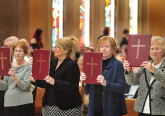Ten things to consider for the RCIA
Wednesday, February 24, 2010
By Father Rick Hilgartner
During Lent in parishes nationwide and around the world, candidates for the sacraments of initiation (baptism, confirmation and Eucharist) experience final preparation to become members of the Catholic Church. The “elect,” as they are called, depend on the support and the encouragement of the whole church to both welcome them and join with them in following Christ. Here are 10 things Catholics can do to help them on their way:
• Pray: Parishes post the names, and often photos, of those preparing for baptism and reception into the full communion of the Catholic Church, so that the community can offer support. Parishioners can commit to pray for a particular member of the elect and let them know of this gift of prayer as they prepare for baptism.
• Listen: The journey of those in the Rite of Christian Initiation of Adults (RCIA) can be an example for all, as the Elect listen intently to the word of God and take concrete steps to follow Him. Their steps can inspire, especially during Lent as Christians strive to follow the Lord more closely. Time spent hearing their stories and experiences can move listeners’ hearts.
• Participate: The RCIA process includes a number of public rituals in Lent: the Rite of Election, the scrutinies and the preparation rites. Many of these take place at Sunday Masses in parishes. Attending those Masses is a way to show support for the elect.
• Attend the Easter Vigil: The great Vigil of Easter is the “night of nights,” the liturgy for Holy Saturday declares. It is the night during which the church keeps vigil for the resurrection of Jesus. It is during the Easter Vigil that the sacraments of baptism and confirmation are celebrated and new members are welcomed into the church. This “most blessed of all nights,” as the Exsultet on Holy Saturday proclaims, celebrates in ancient rituals the central mysteries of the faith. This celebration is long, but it is the heart of the church’s worship and speaks clearly to fill participants with the joy of the resurrection.
• Have a welcoming spirit: In the weeks after their initiation, the newly baptized, now called “neophytes,” look for their place in the church community. Parishioners can make them feel welcome by encouraging them to be part of an activity, a group or a ministry.
• Witness: The RCIA reminds people that God is present and active, that He continues to speak to all. It is a reminder that how you act, what you say, and what you do can reflect the presence of Christ. Being “witnesses” (Acts of the Apostles 1:8) of what Christ is doing in one’s life speaks to others.
• Invite: As witnesses, Christians are called to share their faith in some way. Sometimes it means noticing others who are searching, who might benefit from encouragement or an invitation to learn more about the Catholic faith. Evangelization calls for a member of the church to share one’s faith. Just inviting a friend or neighbor to Mass can be a powerful statement that allows the Lord to reach out through this gesture.
• Get involved: The RCIA has many facets. Each depends on dedicated parishioners (along with the clergy, catechists and other staff members) to facilitate, teach, lead, and serve as sponsors. There are many ways to shares one’s faith and gifts to become involved.
• Ongoing conversion: In addition to those preparing for baptism, the RCIA also includes those already baptized Christians who are preparing for reception into the full communion of the Catholic Church. This can be celebrated any time. Those preparing for reception (and confirmation and first reception the Eucharist) remind Christians that all are called to follow the Lord, who is always speaking and calling people to repentance — ongoing conversion and a change of heart — resulting in more authentic disciples.
• Know that mystagogy is for all: After celebrating the sacraments of baptism, confirmation and Eucharist, the newly initiated continue their formation in the faith in the period called mystagogy (which means “interpretation of mystery”), when they reflect on their encounter with Christ in the sacraments and learn more about their faith. This period is ongoing and essentially what all members of the church do throughout our lives: grow deeper in faith and relationship with Christ, constantly discerning His will.
Father Hilgartner is assistant director of the Secretariat of Divine Worship at the United States Conference of Catholic Bishops.
See related story: More than 1,000 prepare to enter church at Easter













